Mindfulness practices enhance focus and well-being by promoting present-moment awareness. These techniques reduce stress, improve concentration, and foster emotional regulation. Various methods, such as focused breathing and body scanning, effectively enhance cognitive function. Consistent practice addresses common challenges and incorporates practical strategies for better engagement.
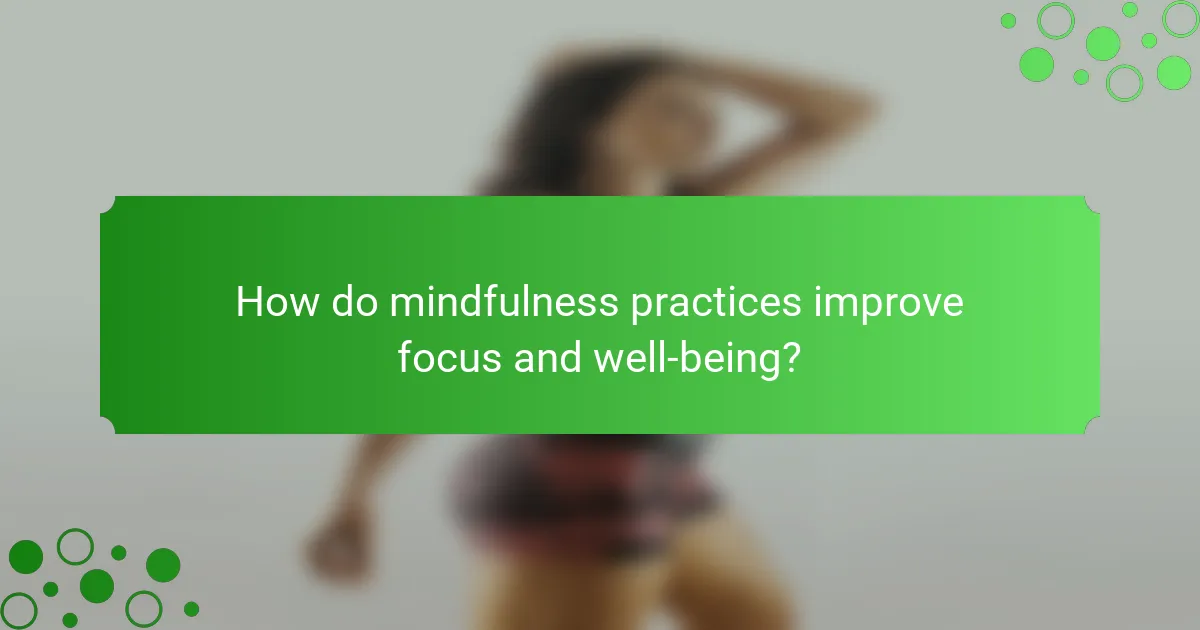
How do mindfulness practices improve focus and well-being?
Mindfulness practices significantly enhance focus and well-being by promoting present-moment awareness. These techniques reduce stress, improve concentration, and foster emotional regulation. Research indicates that mindfulness can increase gray matter density in brain regions linked to attention and self-awareness. Regular practice leads to better cognitive flexibility, allowing individuals to shift focus effectively. By cultivating a non-judgmental attitude, mindfulness enhances resilience against distractions, ultimately improving overall mental health and productivity.
What are the psychological benefits of mindfulness practices?
Mindfulness practices enhance focus and well-being by reducing stress, improving emotional regulation, and increasing self-awareness. Regular engagement in mindfulness can lead to significant psychological improvements. Research indicates that mindfulness can decrease anxiety levels by up to 30%, promoting a calmer mental state. Additionally, it fosters resilience against negative emotions, which contributes to overall mental health. Practicing mindfulness regularly can also enhance cognitive flexibility, allowing individuals to adapt more effectively to changing circumstances.
How does mindfulness enhance cognitive function?
Mindfulness enhances cognitive function by improving focus, attention, and memory. Regular mindfulness practices, such as meditation and deep breathing, increase the brain’s ability to process information efficiently. Studies show that mindfulness can lead to structural changes in the brain, particularly in areas associated with cognitive control and emotional regulation. This results in better decision-making and enhanced problem-solving skills. Additionally, mindfulness reduces stress, which can otherwise impair cognitive performance.
Why is emotional regulation important in mindfulness?
Emotional regulation is crucial in mindfulness as it enhances self-awareness and promotes well-being. By managing emotions effectively, individuals can maintain focus and reduce stress. This practice leads to improved mental clarity and a more balanced emotional state. Mindfulness techniques, such as deep breathing and meditation, support emotional regulation by fostering a non-judgmental awareness of thoughts and feelings. As a result, practitioners can respond to challenges with greater resilience.

Which mindfulness techniques are most effective for enhancing focus?
Mindfulness techniques such as focused breathing, body scanning, and mindful observation are effective for enhancing focus. Focused breathing helps center attention on the present moment, reducing distractions. Body scanning promotes awareness of physical sensations, fostering a deeper connection to the body and mind. Mindful observation encourages individuals to engage with their surroundings, enhancing concentration on tasks. These practices collectively improve cognitive function and overall well-being.
How do meditation and breathing exercises differ in focus enhancement?
Meditation enhances focus through mental clarity and calming of the mind, while breathing exercises improve focus by increasing oxygen flow and reducing stress. Both practices support mindfulness but differ in techniques and physiological impacts. Meditation often emphasizes visualization or mantra repetition, promoting deeper mental engagement. In contrast, breathing exercises involve rhythmic inhalation and exhalation, fostering immediate relaxation and alertness. This unique attribute of breathing exercises makes them accessible for quick focus enhancement during daily tasks.
What role does mindful movement play in concentration?
Mindful movement significantly enhances concentration by promoting awareness and reducing distractions. Engaging in practices like yoga or tai chi fosters a deep connection between body and mind, facilitating focus. Research shows that mindful movement can improve cognitive performance and attention span, leading to better overall well-being. Regular participation in these activities cultivates a unique attribute of sustained mental clarity, essential for effective concentration.
How can journaling support mindfulness practices?
Journaling enhances mindfulness practices by promoting self-reflection and emotional awareness. It allows individuals to process thoughts and feelings, improving focus and clarity. Regular journaling can also reduce stress and anxiety, contributing to overall well-being. Engaging in this practice helps solidify mindfulness techniques, making them more effective in daily life.
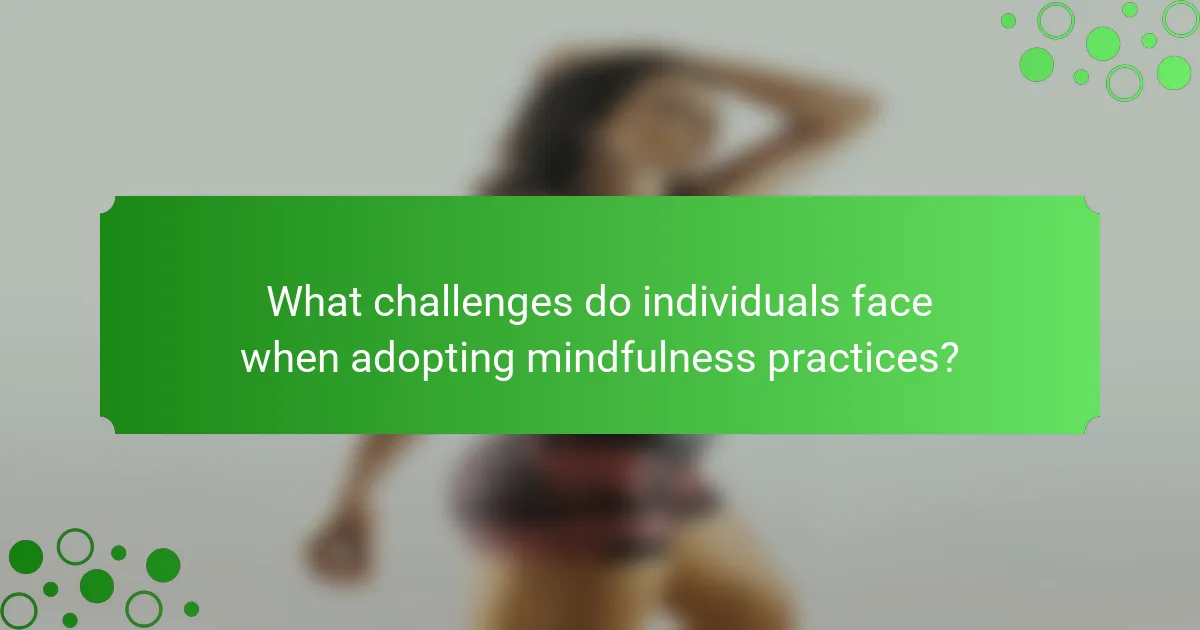
What challenges do individuals face when adopting mindfulness practices?
Individuals often face challenges such as distractions, time constraints, and skepticism when adopting mindfulness practices. Distractions can hinder focus, making it difficult to maintain a consistent practice. Time constraints may lead to the perception that mindfulness requires more time than available. Skepticism about the effectiveness of mindfulness can also prevent full engagement. These challenges can impede the potential benefits of enhanced focus and well-being that mindfulness offers.
How can distractions impact mindfulness effectiveness?
Distractions significantly reduce mindfulness effectiveness by disrupting focus and increasing stress. When individuals engage in mindfulness practices, external interruptions can prevent them from fully experiencing the present moment. A study found that consistent distractions can diminish the benefits of mindfulness, such as improved emotional regulation and reduced anxiety. To enhance mindfulness, it is essential to create a distraction-free environment, allowing individuals to engage more deeply with their practices.
What common misconceptions exist about mindfulness?
Many misconceptions about mindfulness hinder its practice. One common belief is that mindfulness requires emptying the mind, while it actually involves observing thoughts without judgment. Another misconception is that mindfulness is solely about relaxation; it also enhances focus and emotional regulation. Some think mindfulness is a quick fix, but it requires consistent practice for lasting benefits. Lastly, many assume mindfulness is only for certain individuals, while it can be beneficial for anyone seeking improved well-being.
How does cultural background influence mindfulness practice?
Cultural background significantly shapes mindfulness practices and their effectiveness. Different cultures have unique approaches to mindfulness, influenced by historical, spiritual, and social contexts. For example, Eastern traditions emphasize meditation and awareness, while Western practices may focus on cognitive techniques and stress reduction.
These cultural nuances affect how individuals engage with mindfulness, impacting their focus and overall well-being. Research indicates that culturally adapted mindfulness programs yield better outcomes, as they resonate more deeply with participants.
Moreover, cultural values can dictate the perceived importance of mindfulness, influencing its integration into daily life. In some cultures, communal practices enhance mindfulness, fostering social connections that support individual well-being.
Understanding these cultural influences is crucial for tailoring mindfulness practices to diverse populations, ensuring they are relevant and effective.
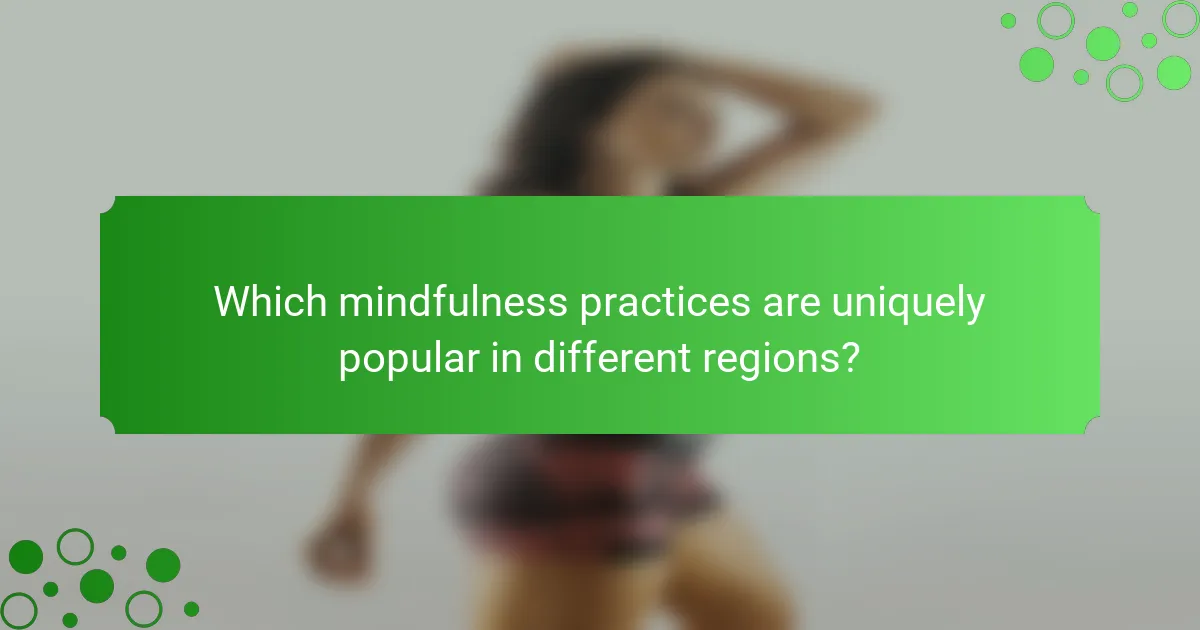
Which mindfulness practices are uniquely popular in different regions?
Mindfulness practices vary significantly across regions, each emphasizing unique techniques. In Asia, meditation and breath awareness are prevalent, focusing on inner peace. In North America, mindfulness-based stress reduction combines meditation with cognitive therapy, enhancing mental clarity. European practices often incorporate nature walks, integrating mindfulness with environmental awareness. In Africa, community rituals emphasize collective mindfulness, fostering social connections. Each region’s approach reflects cultural values and societal needs, enriching the global mindfulness landscape.
How does the perception of mindfulness vary across North America?
The perception of mindfulness varies significantly across North America. In urban areas, mindfulness is often viewed as a tool for stress reduction and productivity enhancement. Conversely, in rural communities, it may be associated more with spiritual practices and holistic well-being.
Cultural influences shape these perceptions. For instance, mindfulness practices rooted in Asian traditions are more prevalent in coastal cities, while indigenous practices may emphasize connection to nature and community. Research indicates that 30% of North Americans engage in some form of mindfulness, with variations in techniques and frequency of practice.
Demographics also play a role. Younger populations tend to adopt secular mindfulness techniques, while older generations may prefer traditional forms. Accessibility to mindfulness resources, such as apps and workshops, further influences engagement levels across different regions.
What mindfulness practices are gaining traction in Europe?
Mindfulness practices gaining traction in Europe include meditation, breathwork, and mindful movement. These approaches enhance focus and well-being by promoting mental clarity and emotional resilience.
Meditation techniques such as mindfulness-based stress reduction (MBSR) are increasingly popular, with studies showing a significant reduction in anxiety levels among practitioners. Breathwork, which emphasizes controlled breathing, has been linked to improved concentration and emotional regulation. Mindful movement practices, including yoga and tai chi, foster physical health while cultivating a mindful mindset.
As a result, these practices contribute to a growing culture of well-being across Europe, with many organizations integrating mindfulness into workplace wellness programs.
How are traditional practices integrated into modern mindfulness?
Traditional practices are integrated into modern mindfulness through techniques that enhance focus and well-being. These practices, such as meditation and breathing exercises, are rooted in ancient traditions and adapted for contemporary lifestyles. For example, mindfulness meditation emphasizes present-moment awareness, a concept found in various cultures.
The unique attribute of these practices lies in their adaptability; they can be tailored to fit individual needs and environments. Additionally, rare attributes like the incorporation of sound healing or nature immersion provide diverse methods to deepen mindfulness experiences.
As a result, modern mindfulness retains the essence of traditional practices while promoting mental clarity and emotional balance in today’s fast-paced world.
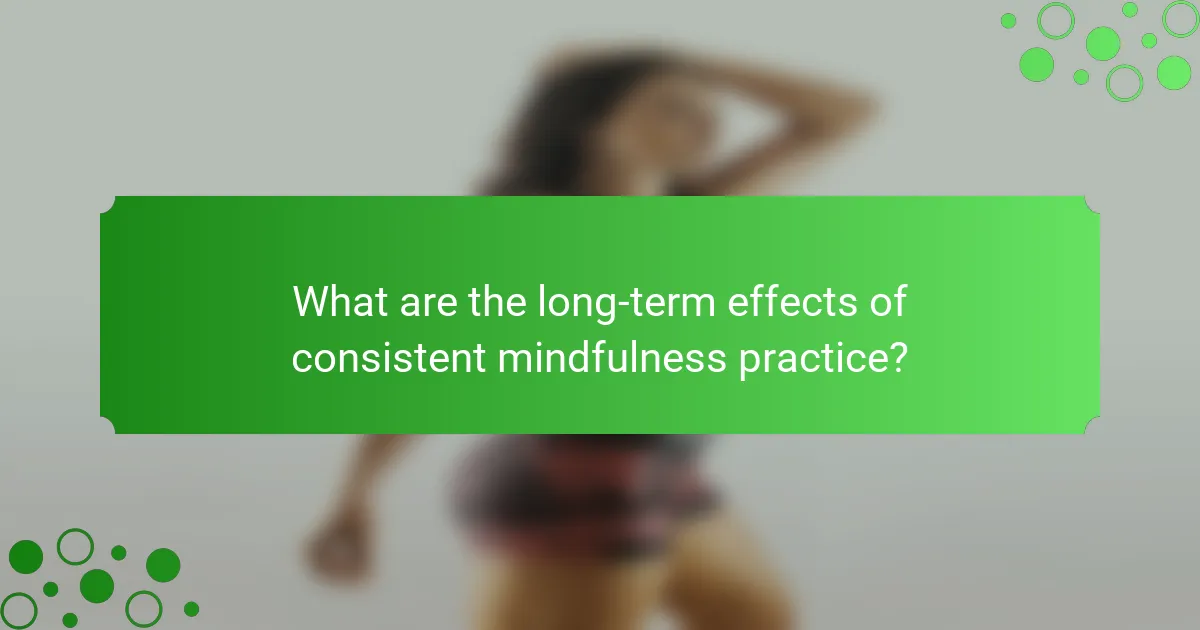
What are the long-term effects of consistent mindfulness practice?
Consistent mindfulness practice leads to improved focus, emotional regulation, and overall well-being over the long term. Research indicates that regular engagement in mindfulness enhances cognitive flexibility and reduces stress levels. Individuals often experience better sleep quality and lower anxiety, contributing to a healthier lifestyle. Additionally, mindfulness can foster greater resilience, enabling individuals to cope more effectively with challenges.
How does mindfulness influence overall health and longevity?
Mindfulness significantly enhances overall health and longevity by reducing stress and promoting emotional well-being. Regular mindfulness practices, such as meditation and deep breathing, can lower blood pressure and improve immune function. Research indicates that individuals who engage in mindfulness report better mental clarity and focus, leading to healthier lifestyle choices. Additionally, mindfulness fosters resilience, which is linked to longer life expectancy by mitigating the effects of chronic stress and enhancing coping mechanisms.
What research supports the effectiveness of mindfulness over time?
Research indicates mindfulness practices enhance focus and well-being over time. Longitudinal studies show sustained benefits, including reduced stress and improved cognitive function. For example, a study published in the Journal of Happiness Studies found that participants practicing mindfulness regularly reported higher levels of life satisfaction and emotional regulation over a year. Another research published in Psychological Science demonstrated that mindfulness training significantly improved attention span and task performance in participants after six months. These findings suggest that consistent mindfulness practice fosters lasting mental and emotional improvements.
How does mindfulness contribute to resilience and adaptability?
Mindfulness significantly enhances resilience and adaptability by promoting emotional regulation and reducing stress. Practicing mindfulness helps individuals remain present, allowing them to respond to challenges with clarity. This practice fosters a growth mindset, encouraging flexibility in thinking and behavior. Research indicates that regular mindfulness practice leads to improved coping strategies, enabling better responses to adversity. Furthermore, mindfulness strengthens neural pathways associated with resilience, making individuals more adept at navigating change.
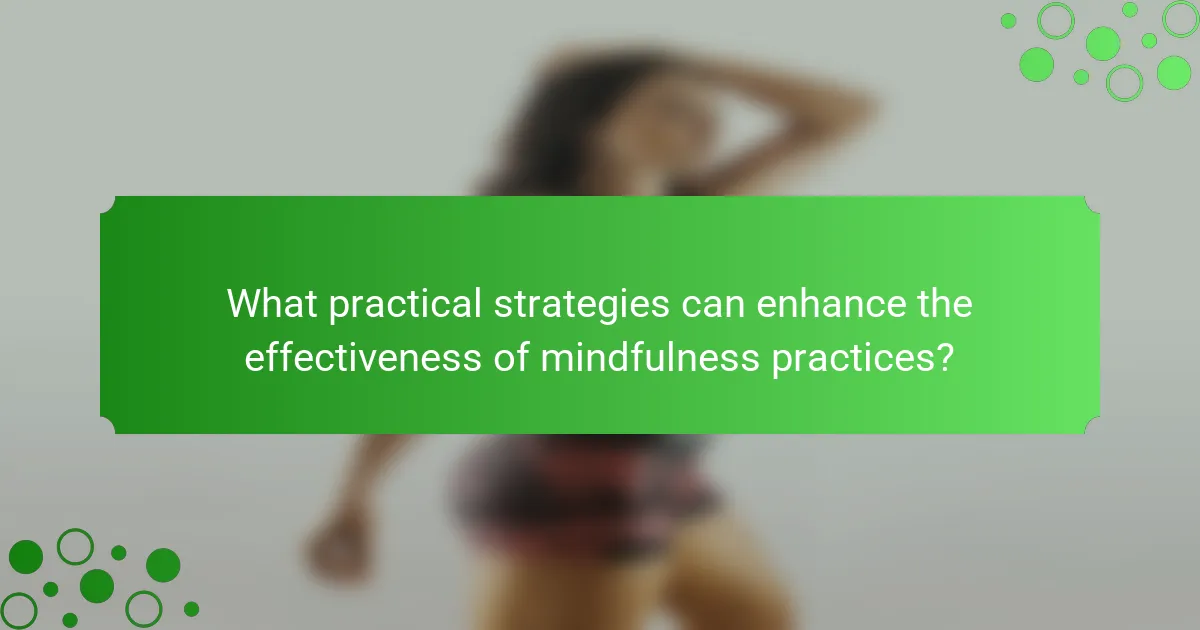
What practical strategies can enhance the effectiveness of mindfulness practices?
Incorporating practical strategies can significantly enhance the effectiveness of mindfulness practices. Focus on consistency, as daily practice cultivates greater awareness.
Engage in breath-focused exercises to ground attention, which improves concentration. Utilize guided meditations to provide structure and direction, making it easier for beginners.
Incorporate mindfulness into daily activities, such as eating or walking, to reinforce presence throughout the day. Set specific intentions for each session to clarify goals and deepen the practice.
Finally, create a conducive environment by minimizing distractions, which fosters a more immersive experience.
How can individuals create a conducive environment for mindfulness?
Individuals can create a conducive environment for mindfulness by minimizing distractions and fostering tranquility. Start by designating a quiet space, free from noise and interruptions. Incorporate natural elements like plants or soft lighting to enhance the atmosphere. Establish a routine that includes regular mindfulness practices, such as meditation or deep breathing. Consistency in timing and location reinforces the habit. Additionally, limit digital device usage during mindfulness sessions to maintain focus. These strategies collectively support enhanced focus and well-being through mindfulness.
What tips do experts recommend for maintaining a consistent practice?
Experts recommend several strategies for maintaining a consistent mindfulness practice. Establish a daily routine to create a habit. Start with short sessions, gradually increasing duration as comfort grows. Incorporate mindfulness into daily activities, such as eating or walking, to enhance awareness. Utilize guided meditations or mindfulness apps for structure and support. Lastly, join a community or group for accountability and shared experiences.
What common mistakes should be avoided in mindfulness practice?
Common mistakes in mindfulness practice include lack of consistency, unrealistic expectations, and distractions. Practitioners often skip sessions, which hinders progress. Setting achievable goals enhances focus and well-being. Distractions, such as multitasking, can disrupt mindfulness. Prioritizing a quiet space fosters deeper engagement.